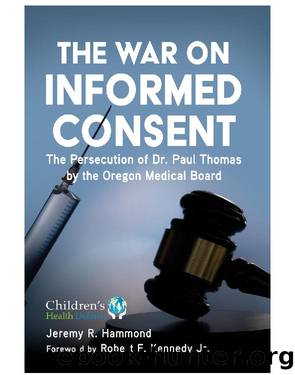The War on Informed Consent by Jeremy R. Hammond

Author:Jeremy R. Hammond
Language: eng
Format: epub
ISBN: 9781510769090
Publisher: Skyhorse
Published: 2021-11-14T16:00:00+00:00
Figure 3 from the study shows the percentage of days during early childhood in which the body burden of aluminum in children exceeds the corrected minimum safe level, comparing the CDCâs schedule and Dr. Paul Thomasâs vaccine-friendly plan.
What they found was that vaccination during the first year of life was associated with twice the odds of being diagnosed for developmental delays and ear infections and over four times the odds for asthma.
When doing a quartile analysis based on the number of vaccines received (with combination vaccines being counted as a single vaccine), the pattern was one of peaking during the second or third quartiles for asthma and developmental delays, respectively. They commented that â[t]his may indicate the presence of âhealthy user biasâ within the overall sample where healthy subjects continue to vaccinate but subjects with health issues limit or curtail further vaccination,â as had previously been observed by researchers. âIn other words, healthier vaccinated children are more likely to stay âup-to-dateâ with vaccinations, whereas children showing health issues may opt for a delayed schedule or to skip specific vaccines.â
This bias was minimized by directly comparing the number of vaccine doses through quartiles with outcomes for completely unvaccinated children. While the âhealthy userâ effect would bias their findings in favor of finding children who receive the most vaccines to have the least odds of diagnoses, there was also the potential for other confounding factors to bias their results in favor of finding unvaccinated children to be those at lowest odds of receiving a diagnosis. Nevertheless, as they commented, for some confounder to explain their increased odds of diagnosis, âit would need to be twice as frequent in vaccinated children.â
They identified the main limitation of their study as being the use of a convenience sample from three practices whose pediatric populations were not characteristic of the general childhood population in the United States. Vaccine uptake was relatively low, with 30.9 percent of the sample receiving no vaccines before age one. The incidence of diagnosed autism in the study population was 0.5 percent compared with the national estimate of 1.7 percent. The incidence of diagnosed ADD or ADHD was 0.7 percent compared to the national estimate of 9 percent.10
One theoretical explanation for their findings is that the unvaccinated children had just as much incidence of ear infections, asthma, and developmental delays, but that they were less likely to be diagnosed because parents who decline all vaccines are less likely to take their children in to see a doctor. On the other hand, if we assume that such parents do utilize health care less frequently, it does not necessarily mean that their children are equally unhealthy but underdiagnosed. The possibility remains that their children really are generally healthier than children whose parents vaccinate to one extent or another.
Accordingly, the authors called for further research to be done using larger sample populations from a variety of pediatric practices.
Download
This site does not store any files on its server. We only index and link to content provided by other sites. Please contact the content providers to delete copyright contents if any and email us, we'll remove relevant links or contents immediately.
Spare by Prince Harry The Duke of Sussex(5078)
Machine Learning at Scale with H2O by Gregory Keys | David Whiting(4199)
Fairy Tale by Stephen King(3225)
Will by Will Smith(2795)
Hooked: A Dark, Contemporary Romance (Never After Series) by Emily McIntire(2502)
The Bullet Journal Method by Ryder Carroll(2488)
Rationality by Steven Pinker(2291)
Can't Hurt Me: Master Your Mind and Defy the Odds - Clean Edition by David Goggins(2230)
It Starts With Us (It Ends with Us #2) by Colleen Hoover(2204)
Friends, Lovers, and the Big Terrible Thing by Matthew Perry(2126)
The Becoming by Nora Roberts(2091)
Love on the Brain by Ali Hazelwood(1965)
HBR's 10 Must Reads 2022 by Harvard Business Review(1782)
The Strength In Our Scars by Bianca Sparacino(1778)
A Short History of War by Jeremy Black(1764)
Leviathan Falls (The Expanse Book 9) by James S. A. Corey(1651)
515945210 by Unknown(1602)
A Game of Thrones (The Illustrated Edition) by George R. R. Martin(1594)
Bewilderment by Richard Powers(1541)
